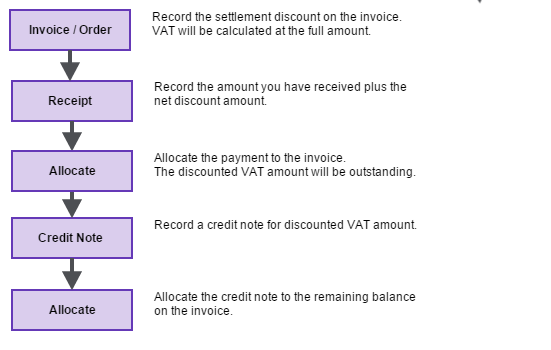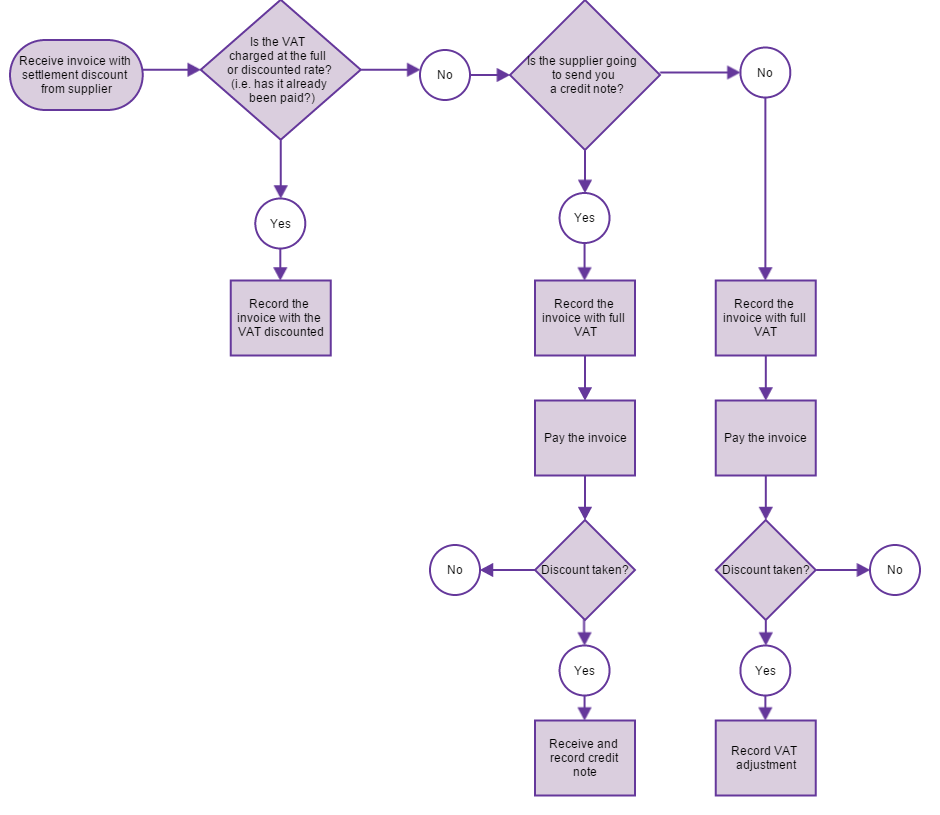Settlement discounts
A settlement discount is where a business offers another business a discount when an invoice is paid early. This is usually a percentage discount if an invoice is paid within a specified number of days, for example, a 5% discount for invoices paid within 15 days.
Settlement discounts can be recorded for both sales and purchase transactions - the discounts that you allow your customers and the discounts that your suppliers give you.
Settlement discounts and VAT
UK
When an invoice that contains settlement discount is paid within the settlement discount period, the VAT is only charged on the discounted invoice amount. VAT must be calculated and shown on the invoice at the full rate. If the customer pays within the settlement discount period, the VAT is discounted and a VAT adjustment must be processed.
The HMRC requires businesses to:
-
Notify their customers of the VAT discount available and the amounts the customer is due to pay. This can be done in one of two ways:
- Issue an invoice detailing the full net and VAT payable. If the invoice is paid within the discount period, issue a further VAT only credit note to account for the VAT discount.
- Issue an invoice document which states the amount of discount (net and VAT) that can be claimed if the invoice is paid early, as well as the full amount (net and VAT) due after the settlement discount period. If the invoice is paid within the discount period, there is no need to issue an additional credit note. However, internal VAT adjustments will be required.
- When an invoice is paid immediately, the settlement discount is automatically taken. The VAT is discounted on the invoice and no subsequent VAT adjustment is necessary.
Ireland
In Ireland, VAT is always charged at the full value of the invoice, regardless of any settlement discounts.
Settlement discounts on sales
For sales transactions, the VAT is now calculated at the full value of the invoice by default.
When a customer pays within the settlement period, the net and VAT discounts will apply to the invoice. As the VAT has already been recorded at the full rate, you will need to enter adjustments to account for the VAT discount taken by the customer. These adjustments can be recorded in Sage 200 as VAT only credit notes. If you're printing your invoices from Sage 200, then correct text is printed on the invoice by default so there's no need to print and send this credit note to your customers.
How you record these credit notes depends on the business processes you want to use. You may want to process them per invoice or enter a number of adjustments as one credit note per customer.
For details on how to process transactions with settlement discounts, see Recording settlement discounts on sales.
Settlement discounts on purchases
For purchase transactions, the process you follow will depend on how your supplier deals with any settlement discounts they offer you. The wording on the invoice you receive should indicate whether your supplier will send you a credit note for the VAT discount. You may receive invoices in the following scenarios:
-
The supplier sends you an invoice with the VAT calculated at the full value of the invoice. This invoice also includes details of any settlement discounts due. When you pay the invoice, you take the discount and pay the reduced amount.
In this case, you'll need to enter an adjustment to account for the discounted VAT.
-
The supplier sends you an invoice with the VAT calculated at the full value of the invoice. When you pay the invoice, you take the discount and pay the reduced amount. The supplier sends you a VAT only credit note for the VAT discount.
In this case, you'll need to enter the credit note when you receive it. You won't need to process additional VAT adjustments.
-
You've already paid the invoice, so the VAT on the invoice has already been discounted.
In this case, you need to record the invoice with the VAT discount. No further adjustments are necessary.
For details on how to process transactions with settlement discounts, see Recording settlement discounts on purchases.
Sage is providing this article for organisations to use for general guidance. Sage works hard to ensure the information is correct at the time of publication and strives to keep all supplied information up-to-date and accurate, but makes no representations or warranties of any kind—express or implied—about the ongoing accuracy, reliability, suitability, or completeness of the information provided.
The information contained within this article is not intended to be a substitute for professional advice. Sage assumes no responsibility for any action taken on the basis of the article. Any reliance you place on the information contained within the article is at your own risk. In using the article, you agree that Sage is not liable for any loss or damage whatsoever, including without limitation, any direct, indirect, consequential or incidental loss or damage, arising out of, or in connection with, the use of this information.


